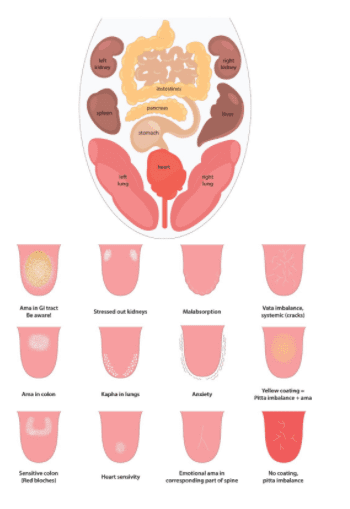
Toxic Goo-What Your Ama Telling is You?
Eewy, gooey, toxic sludge. Sticky, thick and yellow. Waste. No, I’m not on the wrong holiday, and this isn’t a throwback to Halloween. This is AMA. Ama is the byproduct of poor digestion – not just digestion of food, but also of life experiences. In a body where ama is present, so are illness and disease. Expect to have health, energy and balanced emotions in a body that is ama free. Understanding the Ayurvedic concept of ama, how it is formed, its signs and symptoms, will help you to be free from its swampy grips and avoid future illness.
Do a Morning Tongue Check for Ama
 Do you have ama? First thing in the morning, take a look at your tongue. You are looking for the white or yellow stuff. Check how much of the tongue it coats, how thick the coating appears, and the color of the coating all tell us something about the ama that is in your body. Since the tongue is at the top of the digestive tract you can think of it as a map to all that is happening within. Anything other than a nice pink tongue and you can rest assured, you have an accumulation of ama in your system.
Do you have ama? First thing in the morning, take a look at your tongue. You are looking for the white or yellow stuff. Check how much of the tongue it coats, how thick the coating appears, and the color of the coating all tell us something about the ama that is in your body. Since the tongue is at the top of the digestive tract you can think of it as a map to all that is happening within. Anything other than a nice pink tongue and you can rest assured, you have an accumulation of ama in your system.
In Ayurveda, all health comes from the strength of the digestive system. In a strong but balanced digestive system, there are only two functions: first, food is broken down into very small particles, and the particles are absorbed into your bloodstream via the small intestine. Second, anything that is not necessary to meet your body’s nutritional needs is excreted via the bladder and large intestine. Strong digestion does not produce ama, which is a bi-product of weak digestion. When you have strong digestive function you will feel light and energized after you eat. Nothing “hangs around” longer than need be. You use your food efficiently, building prana (life force) with ease, and eliminating waste product with ease. This is ideal, and will create wonderful health.
Weak Digestion Creates Ama
When digestion is weak or unbalanced, there is a third function of the digestive system. Perhaps food doesn’t break into small enough pieces, or perhaps it sits, stagnating and fermenting, in a digestive tract that is not moving efficiently. In either case, not all food is absorbed or eliminated. This is ama. Ama is the portion of undigested waste that stays in the body. Unused and unable to be eliminated, it becomes the Swamp-Thing of the digestive tract, growing stickier, thicker, and more unctuous with time, and is stored in the storage tissues, particularly fat cells and joint spaces. The good news hidden here- sometimes being overweight is not a function of fat, but a function of stored ama. Eliminate ama=eliminate excess from the fatty tissues.
All Kinds of Ama
While we are talking about how ama is created, we need to think critically about the false concept that food is the only thing which we take in that needs digesting.  In fact, food is only a small part of all that you take in each day. There is the breath, and the quality of the air around you. There is information, via screens, media, books and music. There are your interactions with friends, family, co-workers and strangers. There is anything and everything that causes an emotional response. Information, breath and emotions, as they rise, must be digested, or even they will be stored as ama in the body or the mind. Unprocessed emotions or unprocessed information lead to “emotional ama.” While there is technically no difference between foodborne ama and emotional ama, they both lead to physical symptoms. The physical symptoms (Somatics) that arise after any type of trauma are due to emotional ama.
In fact, food is only a small part of all that you take in each day. There is the breath, and the quality of the air around you. There is information, via screens, media, books and music. There are your interactions with friends, family, co-workers and strangers. There is anything and everything that causes an emotional response. Information, breath and emotions, as they rise, must be digested, or even they will be stored as ama in the body or the mind. Unprocessed emotions or unprocessed information lead to “emotional ama.” While there is technically no difference between foodborne ama and emotional ama, they both lead to physical symptoms. The physical symptoms (Somatics) that arise after any type of trauma are due to emotional ama.
Ama actually translates to mean “uncooked”. When we can’t metabolize something, be it food, breath, information, or emotion, there is a lack of the necessary transformative energy that is needed for that thing to be digested. Unmetabolized, or uncooked, those things that should feed our senses instead create toxicity. Toxicity equals ama.
Symptoms of Ama in Your Body
Many symptoms that precursor disease are a sign that excess ama has built up in your body. You may have one system that is prone to collecting ama and shows symptoms earlier than others. For example, one person may have chronic stomach upset, another headaches, and yet a third may have chronic rashes. Yet all of these people likely have one thing in common: ama. The more attuned you become to this, the more sensitively you may notice signs and symptoms before they lead to disease. Attune to ama buildup and you may notice the first hint of a stomach-ache (and take action to clear the ama) before it leads to full blown IBS. Here is a list of symptoms, both subtle and not, that may indicate ama in your body:
- Depression/Irritability
- Joint pain or stiffness upon rising
- General Pain including headaches
- Feeling tired, lazy, drowsy or weak.
- Heaviness or fatigue after eating
- Gas or Bloating
- Chronic inflammation
- Constipation or mucous in the stool
- Belching or burping frequently
- Susceptibility to illness
- Overweight
- Oily or sticky skin with sweat
- Body odor or bad breath
- Difficulty thinking or remembering things
- “Brain fog”
- “Leaky gut”
Now that you understand what ama is and how it manifests as symptoms in the body, you need to understand what “harmless” habits you may be keeping that are contributing to ama in the first place.
Four Ways You May be Unknowingly Creating Ama in Your Body
1. The most significant way you may be creating ama in your body is eating too heavy too late.  When you eat too late (after 6pm) your body literally lacks the metabolic force (called agni in Ayurveda) to break down your food. Similarly, when you eat too much at one sitting, you smother the proverbial digestive fire. Most people become lazy after a late, heavy dinner and lie on the couch, where even gravity cannot help the digestive cause. There is a reason that eating an earlier, lighter dinner is the first habit we teach as Yoga Health Coaches. To avoid ama accumulating on a nightly basis, eat early, eat light and stay active.
When you eat too late (after 6pm) your body literally lacks the metabolic force (called agni in Ayurveda) to break down your food. Similarly, when you eat too much at one sitting, you smother the proverbial digestive fire. Most people become lazy after a late, heavy dinner and lie on the couch, where even gravity cannot help the digestive cause. There is a reason that eating an earlier, lighter dinner is the first habit we teach as Yoga Health Coaches. To avoid ama accumulating on a nightly basis, eat early, eat light and stay active.
2. A second big contributor to ama is our habit of taking in food, substances or information to avoid or control how we are feeling. In reality the emotional experience is the emotional experience regardless of how much food, alcohol, or media you take in to avoid feeling it. You know the expression! Wherever you go, there you are. You cannot escape your inner self by switching focus to your taste buds! If your mental and emotional bodies are busy contending with a heavy load, putting in food or other distractive substances leads immediately to ama. You just can’t digest both things. This is why you lose your appetite when something major happens. It’s your body’s wise way of saying “tune in and attend to me.” So do it.
 3.The third heavy hitter on ama production is eating foods that aren’t fresh or those that are processed. This one is a bit of a no-brainer. Eat food that is seasonal and local and comes from a source close to the earth and your body will know just what to do with it. Eat food that is canned, boxed, old or processed and it is like ama in a to go box. Use common sense and eat fresh, organic and green whenever possible to avoid digestive bi-product.
3.The third heavy hitter on ama production is eating foods that aren’t fresh or those that are processed. This one is a bit of a no-brainer. Eat food that is seasonal and local and comes from a source close to the earth and your body will know just what to do with it. Eat food that is canned, boxed, old or processed and it is like ama in a to go box. Use common sense and eat fresh, organic and green whenever possible to avoid digestive bi-product.
4. My fourth example of how you may be creating ama in your body is a little less intuitive, and something that may contradict what you have heard from popular health and medical authorities. Eating too frequently as in, “five small meals a day” is a major offender in producing ama. Why? That metabolic force we were talking about – agni – is a fire that needs tending. To burn food efficiently it needs time to process, to turn food into ash, to smolder, and to rebuild. Add little bits of kindling over and over to the fire and it never recovers its intensity to handle all the rest of the stuff that is coming in. To put it another way, when you put food in too frequently you are taxing the efficiency of your body’s largest and most central channel. With a little load in the stomach, another in the small intestine, and several more in the large intestine all of your processing energy is stuck on food.This leaves no room for processing information, emotions, and all of the other things we take in on a daily basis. Give the fire a rest between meals (specifically 3-4 hours between and minimum 13 hour fast between dinner and breakfast) and the fire will burn brightly, without subsequent ama.
Hit the Reset Button and Release that Ama
Now you are wondering, what do I do with the ama once it’s accumulated in my system? In Ayurveda we recommend seasonal cleansing, which is the best way to rid the body of the toxins we accumulate in daily life. Seasonal detoxing rids your body of the toxic load before it turns to illness. You can read more on that here. But let’s say you have just returned from vacation where you’ve exceeded your ama quotient by eating excessive pasta, cheese and drinking too frequently (yes, it happens!). My personal reset is a three day mung-bean soup fast. It’s a quick way to purge toxins and support the digestive tract in recovering its strength. And it’s easy! Make a fresh pot of soup each day and eat only that for breakfast, lunch and dinner (it’s only three days). Mung beans are notorious for their cleansing properties and very easy to digest, plus this simple food contains all the nutrients you need to support your body and sustain normal activity. My favorite recipe is here, Simply eat mung soup for three meals per day and drink plenty of fresh, warm water and you will feel as if you’ve hit the proverbial reset button.
Ama Free for Life-NOT!
Even the best yogi can’t be ama free. Toxins are everywhere, even in our clean food and drinking water. However, a daily practice of good habits around eating, allowing yourself space and rest around emotions, and respecting the needs of your senses will allow you to live ama-light between cleanses and give you the sense of vibrant health.



